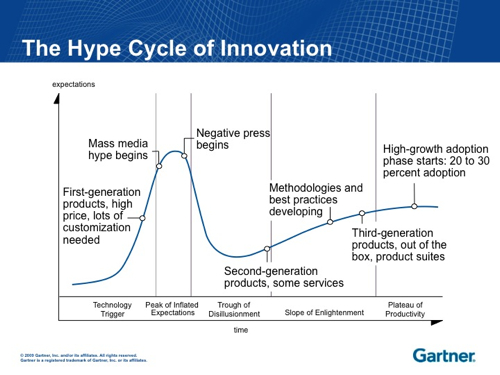
"Where should I invest?" is a critically important question for you
and your company. On a personal level, the answer will determine how
comfortable your retirement is. On a corporate level, the answer influences
whether your company survives and thrives.
Every year, pundits offer their thoughts on the "next big thing," such
as cloud, big data and social media. Coverage of the next big tech investment
trend moves from the business media to a fascinated general audience, resulting
in a wall of noise that is amplified and can make corporate decision makers
suspend rational judgment in favor of novelty or the fear of being left behind.
Think of the "Dot Com Era" around the year 2000 and what we now
know of as "web-to-print." Hundreds of start-ups flush with venture capital
promised to revolutionize how print was created, bought and managed. Printing
companies would be disintermediated and reverse auctions would drive out costs—except
for the big fees the dot-com companies planned to collect ("taxes" the printing
companies called them). Despite the hype, most of those dot-com companies
folded without gaining traction. Yet, many of their core procurement concepts lived
on and morphed into viable products. Ten years later, we have a thriving,
mature web-to-print market.
Web-to-print followed Gartner's Hype Cycle curve from inception to over-enthusiasm
and through a period of disillusionment to the market's eventual adoption of
the technology in some form (see figure 1.) As the curve illustrates, if an
investment is made too soon, then you may suffer through the painful and
expensive lessons associated with an immature technology. One the other hand,
if an enterprise delays action for too long, then it runs the risk of being
left behind by competitors that succeed in making the technology work to their
advantage.

Each year, Gartner creates nearly 100 Hype Cycles as a way for
clients to track technology maturity and future potential. Analysts worldwide
position the technologies on the Hype Cycle based on a consensus assessment of
hype and maturity. We evaluate a variety of relevant market signals and
indicators to determine where technologies are along the curve. Some inputs are
quantitative but overall the Hype Cycle is a structured, qualitative research
tool.
To illustrate the Hype Cycle concept and why it is a valuable strategic
planning resource, let's consider context-enriched content and 3D printing.
Context-Enriched Content
Hype Cycle Position: Technology Trigger
Market Penetration: 1% to 5% of Target Audience
Maturity: Emerging
Sample Vendors: Dai Nippon Printing; HP; Oracle; Pitney Bowes;
Saepio; Salmat; SDL; Xerox
To understand context-enriched content requires a brief description
of what we mean by "context." Simply put, context is the relevant facts about
current conditions that are true in the moment but may not be true in the
future.
Many people assume, often after using a smartphone or tablet to
find a nearby restaurant or business, that context equals location. However,
context may also include information inferred from the user's movements, social
media activity, proximity to other devices and recently accessed content. On
the other hand, the recipient's name, address, credit limit, account number and
status are not context data but reference data that are more or less permanent
characteristics with respect to a particular use.
Context-enriched content (CEC) is defined as the content,
information and data ranging from articles to advertising based on the user's
context that is served to whatever medium the recipient is using. The media may
be a web browser, a mobile phone, a media tablet or printed materials. CEC is
differentiated from traditional communications by incorporating an
understanding of the user's context and needs in the moment.
A common marketing message that is not "context-enriched"
is the bill you receive by mail. A paper bill is limited to "transpromo"
messages that are based on your purchasing history. But when you access the
same information with an iPad, for instance, the biller now knows your
location, time of day and recent (even same-day) transactions, in addition to
past purchasing history. The context-enriched result is targeted,
individualized content that is relevant to you in that moment.
Our advice to technology providers is to leverage their core customer
communications management software offerings to build a publishing platform
that serves up relevant content to Internet, print and mobile device users with
negligible data transfer latency and strong security. For enterprises, your
first application of context-enriched content should be a consumer-focused one
that publishes the highly personal and targeted information that the prospect,
customer or constituent requires. Engage leading-edge providers to develop prediction
algorithms that serve relevant content based on context while ensuring privacy
and security.
3D Printing
Hype Cycle Position: At the Peak of Inflated Expectations
Market Penetration: 5% to 20% of Target Audience
Maturity: Adolescent
Sample Vendors: 3D Systems; Asiga; Beijing TierTime Technology;
Blueprinter; Fab@Home; HP; Leapfrog; MakerBot; pp3dp; RepRap; Stratasys;
Ultimaker
3D printing is defined as a method of converting 3D model data into
a physical, geometrically complex, intricately detailed and potentially
functional model or salable new or replacement part. 3D printers deposit ink,
resin, plastic or another material to build a physical model.
Gartner research focuses on the growing number of 3D printers that
cost less than $20,000.
Industrial 3D fabricating technologies for product prototyping and
short-run part manufacturing have been available since the early 1980s.
Continued quality improvements and price decreases mean enterprises can justify
a modest investment that streamlines their product design and development
programs. 3D printers with multicolor capabilities (less than $15,000) and
single, monochromatic 3D printers (under $10,000) are available for a wide
range of applications, with simple build-your-own-printer kits costing a few
hundred dollars appealing to enthusiastic experimenters.
A sign of the market's growth and maturation is the consolidation
of its technology providers. In 2012, 3D Systems completed its acquisition of Z
Corporation and Stratasys announced its intention to acquire Objet.
Interestingly, the major 2D printer manufacturers basically remain on the
sidelines, mainly conducting research or providing their OEM capabilities to
third parties. HP is the only 2D printer provider with a 3D product offering (DesignJet
printers built by Stratasys), although Xerox and Ricoh have demonstrated Objet
printers at major printing technology exhibitions.
3D printers remain an "adolescent" technology with a
tremendous amount of hype around 3D printing and what it can or cannot do. Uses
for 3D printers have expanded as advances in 3D scanners and design tools make
3D printing practical. Lower capital and operating costs mean the potential
benefits are high enough for many organizations to justify the modest
investment needed to experiment with 3D printing.
Gartner advises enterprises to explore the use of 3D printing
technology in product design and rapid prototyping, as well as for focus groups
and marketing campaigns. For their part, printer technology providers must
continue their research and development work while monitoring competitors'
acquisition and go-to-market initiatives.
In closing, bear in mind these two important points about Hype
Cycles:
- Technologies inevitably progress through a pattern of over-enthusiasm
and disillusionment, followed by eventual productivity - Be selectively
aggressive and move early with technologies that are potentially beneficial to
your business
PETE BASILIERE
is research director in the technology
and service provider organization of Gartner. For more, visit www.gartner.com/Pete-Basiliere.









